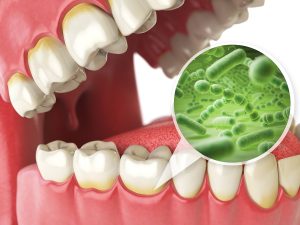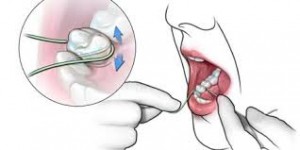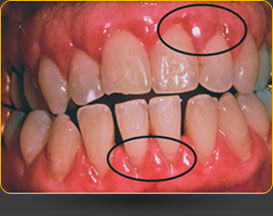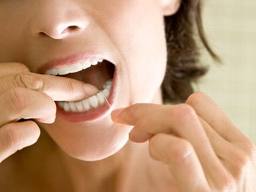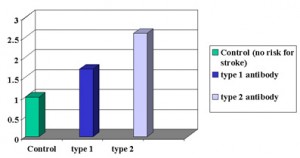You may not be aware that there is a connection between mouth flora and your health. But a recent publication provided proof that certain bacteria can cause esophageal cancer.
Esophageal cancer from certain bacteria
In a 2017 publication a study of mouth flora from 122,000 people showed an association to two types of esophagus cancer. The finding was that the periodontal pathogen Tannerella forsythia had as association with esophageal adenocarcinoma. This cancer is originating from the glandular tissue of the esophagus. In contrast, the bacterium Porphyromonas gingivalis caused another histological type of esophagus cancer, namely esophageal squamous cell carcinoma. This cancer originates from the inner lining of the esophagus. In addition, two mouth bacteria showed a relationship with reduced risk of causing esophageal adenocarcinoma. These two common mouth bacteria were the Neisseria species and the species Streptococcus pneumoniae.
Clinical example of a patient with esophageal cancer
To illustrate this with a clinical case description, here is an example from another publication. This is regarding a man who suffered from esophagus cancer. Initially doctors were puzzled about his diagnosis. He was a 53-year old patient with chronic alcoholic liver disease. He had an increased white blood cell count. A blood culture isolated Parvimonas micra, which is a pathogen normally only living in the mouth flora. A gastroscopy as part of the work-up showed an invasive squamous cell carcinoma of the esophagus. It had almost completely blocked the passage to the stomach. The pathological bacterium had accessed the blood circulation via the tumor mass in the lower esophagus. In the past physicians did not know about these associations.
Brush your teeth and floss every day
Brushing your teeth and flossing everyday controls the bacteria in your mouth. It prevents leakage of bacteria into your blood affecting your heart valves. Studies have shown that this also prevents heart attacks.
The literature on this is clear: chronic gingivitis has a link with bacteria in the mouth. They grow on the gums and can spread into your blood. They can then colonize in your heart valves and even in the lining of the arteries. This is particularly so in cases where there is already hardening of the arteries (arterial plaque). This can lead to heart valve disease like mitral valve disease. If this process occurs in coronary arteries, it can lead to heart attacks.This reminds you that there is a connection between mouth flora and your health.
Mouth wash
Many people feel they have “bad breath” and they need a mouthwash product. This is good marketing for companies that produce mouthwash. However, the truth is you need to be diligent about appointments with a dental hygienist, brush your teeth regularly and floss your teeth. If you suffer of constipation, increase your fiber intake and consider colonics. If you still think you have bad breath, use a natural mint product (read the ingredients). Why do I not like mouthwashes? They kill your mouth bacteria that are naturally there; this can disbalance the rest of your gut bacteria as you swallow part of the mouth flora when you eat or drink fluids. If you still want to use a mouthwash, use one without alcohol and without any carcinogens such as parabens. Also read this 2009 news item. It is as valid as it was then.
Chronic gingivitis and heart disease
It was not until about the mid 1990’s when it became apparent that gum infections and severe tooth decay could cause inflammation in the blood measurable by using the CRP marker (C-reactive protein). Dr. Joseph Muhlestein at the University of Utah demonstrated in 1996 that chronic gum infection could cause a heart attack. He isolated the bacterium Chlamydia pneumoniae in 79% of patients undergoing coronary bypass surgery, while samples from heart transplant patients isolated this bacterium in only about 5%. The new thinking was that bugs that multiply in diseased gums could migrate into the blood and cause platelets from the blood to clump together and block coronary arteries causing heart attacks. Also, restenosis after percutaneous coronary intervention was more likely to occur, if the pathogen count of gum bacteria in the blood was higher.
Infectious causes of endocarditis and heart attacks
Harvard University researchers have confirmed this. In the past physicians did not know that a bad tonsillitis with an aggressive bacterium, Streptococcus viridans, could cause subacute endocarditis, a dangerous infectious disease of the heart valves, which can be responsible for sudden death in younger persons. Neglected cavities in teeth can also harbor this bacterium. Another study in 2009 showed that two particular strains of bacteria in infected gums, Tannerella forsynthesis and Preventella intermedia, showed a connection with an increased risk for heart attacks; but it was more the overall burden of bacteria in the infected gums than the specific bacteria strains that mattered most.
See your dental hygienist regarding your mouth flora and your health
Given this background it is easier to understand that we need to take good care of our teeth and gums, if we want to maintain good health. As a start most people should see their dental hygienist (who usually works in a dentist’s office) twice a year. The dental hygienist will probe the depth of gingival pockets with a periodontal probe. A normal depth measures up to and including 3 mm. Deeper pockets than that usually indicate that the patient did not floss the teeth regularly. One needs to floss at least once per day, better twice per day, and it should not bleed after flossing (initially when a person flosses for the first time the gums tend to bleed a bit).
What the dental hygienist does
The hygienist will do scaling of plaques on the tooth enamel. If the hygienist detects any cavity, he or she will bring it to the attention of the dentist. At the end of the scaling procedure the hygienist will apply fluoride, which puts a coating on the tooth surfaces to prevent tooth decay.
When deeper pockets (6 mm or more) are detected a trial of sub-gingival root brushings has shown to have a very beneficial result within only 14 days.
Periodontal pockets were improved and bacterial counts of periodontal infections also showed improvement.
Mouth flora in alcoholics
This 2016 study from Poland examined the mouth flora of 25 alcoholics. They were compared to the mouth flora of 25 patients from a periodontology clinic.
There were significant differences between the two groups. The alcoholic group had higher bacterial counts of these three strains: Aggregatibacter actinomycetemcomitans, Porphyromonas gingivalis and Treponema denticola. There was no difference in bacterial counts between those who drank only little alcohol compared to those who drank lots. The bacterial concentration in the sub-gingival flora was the same. Patients with severe periodontal disease had the same distribution of the three strains of bacteria as chronic alcoholics. However, the concentration of bacteria in alcoholics was much higher. This fact may explain why chronic alcoholics are very sensitive to infections. Alcohol inhibits the immune system, but stimulates the growth of sub-gingival bacteria, which find their way into the system and in serious cases can kill the patient.
Conclusion
It is now a well-established fact that mouth bacteria play an important role in our health. Some of the healthy bacteria find their way into the gut providing the foundation of a healthy gut flora. But as described above there are also pathological bacteria that can multiply in our mouth cavity and our gums. This happens particularly in people who do not floss and who develop gingivitis and periodontitis. Tannerella forsythia was associated with esophageal adenocarcinoma. In contrast, the bacterium Porphyromonas gingivalis caused esophageal squamous cell carcinoma. Streptococcus viridans could cause subacute endocarditis, a dangerous infectious disease of the heart valves. Tannerella forsynthesis and Preventella intermedia showed an association with an increased risk for heart attacks.
Bacteria associated with alcoholism
Here are three mouth bacteria associated with alcohol consumption and with chronic periodontitis. They are Aggregatibacter actinomycetemcomitans, Porphyromonas gingivalis and Treponema denticola. Don’t let the strange sounding names of mouth bacteria confuse you. Fact is that these bacteria, when entered into the blood vessels and the rest of the body, will play havoc with your health. Keep brushing your teeth at least twice per day and floss your teeth conscientiously once or twice per day as well. This will improve your mouth flora and your health.
More info: https://www.askdrray.com/flossing-and-brushing-saves-your-heart/
